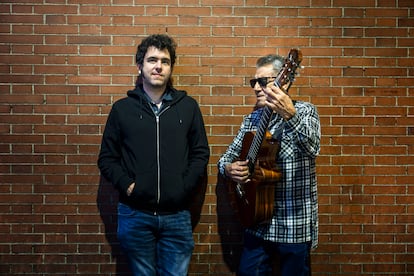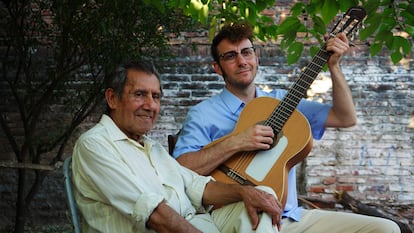Atocha is a hive of people in a hurry early on a Monday morning in October, but Cuti Carabajal, oblivious to the frenetic traffic of contemporary life, is calmly sitting in a cafeteria. “Hello, Mr. Journalist,” he greets with a sweet and welcoming smile. The rush is not going with this 77-year-old Argentine who will play this Tuesday, October 22 at the Galileo room in Madrid and is behind the musical shaman who stars The blue star, the acclaimed film about the story of Mauricio Aznar, leader of the group Más Birras, who, after an existential and artistic search through Argentina, died at the age of 36 from an overdose on October 2, 2000 in Zaragoza.
“The idea of the film seemed great to me,” admits Cuti Carabajal, a musician in real life who, in fact, plays his brother Carlos Carabajal in the film. Carlos was the true musical maestro who, at the end of the nineties, welcomed Mauricio Aznar – played by Pepe Lorente – when he traveled to the Argentine region of Atahualpa with the idea of meeting Atahualpa Yupanqui. “Mauricio’s story is like that of Jacinto Piedra, well known in Buenos Aires. A free boy, a singer, who walked the streets on a bicycle. He always wore red pants and sang wonderfully,” says Cuti Carabajal, who admits that he is “sorry” not to have met the Más Birras singer in person. However, Aznar never found Yupanqui, although, along the way, he ran into Carlos Carbajal, an elderly musician in a downturn who welcomed him into his family and taught him the mysteries of the folklore of the province of Santiago del Estero. “I play my brother Carlos in the film,” says Cuti. “I thought I had to act like he was. That is, he had to be a fun, simple, natural person who always got along with everyone. “He didn’t have a difficult or strange posture, like so many artists in Argentina.”
Outside of strange and difficult positions, Cuti Carabajal, perhaps like his brother, exudes peace, despite the morning hustle and bustle of Atocha. He is accompanied by an aura typical of people who know where they are stepping and do not need to get on moving trains, moved by trends or fashions. Cuti continues the legacy of his brother Carlos, whom many called “father of the chacarera.” “The chacarera is a dance with a choreography and, when dancing it, you have to respect it. “That inhibits many,” explains the musician. “My brother invented a new, different, agile rasguido. He did it with pleasure and it greatly infected the Santiago interpreters. It was favorable for everyone because the new generations of musicians copied him without problem. Many things came out musically and poetically. It is a music that is born with the family. Since we were kids, we have played it at home.”
The chacarera sounds with joy and naturalness in The blue star, a story that, out of the typical biopics, It becomes an existential immersion to find inspiration. As Javier Macipe, director of the film and who, like Mauricio Aznar, followed the same path of search to find the traces that marked the singer and composer of Más Birras on his journey, says: “This film is a Karate Kid musical because of what it has as an inner world. Because it is, at its core, the story of how someone is searching for the light.”

Luz is a word that could be associated with the elderly Cuti Carabajal, who takes small sips of his coffee and is part of a family of “12 brothers and no women.” He, like Carlos and other brothers, dedicated himself to music in order to bring those songs that were played and danced in the patios of Santiago. “My brother Agustín lived in Buenos Aires and separated from Los Cantores de Salavina, a very famous group. When they separated, he looked for three of our family for his new set: my brother Raúl, a nephew and me. That’s where I started,” he recalls. “So, back in the sixties, to do something important in music, you had to do it in Buenos Aires. All the studios and media were there. We traveled on the North Star train, in which all the northern provincials went to look for work in the capital. Work as bricklayers, carpenters… But we showed up with our guitars.” He also played with Los Manseros Santiagueños, another very successful group. “Known in Argentina as the Rolling manseros,” says Javier Macipe, who accompanies Cuti in Atocha and, after his performance at the Pilar festivities in Zaragoza, will also do so at the concert on October 22 at the Galileo room, a event with two passes—at 6:30 p.m. and 9:00 p.m.—.
“I am a folklorist,” says Cuti Carabajal, laughing. “Many have used folklore to go to other music that is not the same, very commercial music,” he points out and, later, names the great composers of Argentine folklore to whom he pays tribute in his songs such as Oscar Vallés, Ariel Petrocelli, León Benarós and Pablo Raúl Trullenque. “I look for inspiration in my house. Quiet and alone. Reading poems already brings me inspiration. There are poems that already come with music.” And he states: “The producer is one thing and the farmer is another. Folklore defends the peasant because he is a humble and hard-working person. Our songs are always on the side of that man or woman who works.”

